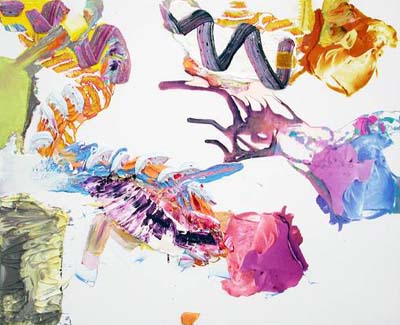 iberdroll, 2003 Oil and silkscreen on wood, 100 x 125 cm (39 3/8 x 49 1/4 in.), signed and dated verso Pia Fries New Works We are happy to present Pia Fries in a show of new works. Her large scaled and vividly colorful paintings have claimed international attention in the last years. Born 1955 in Beromünster, Switzerland, Pia Fries now lives and works in Düsseldorf. Single processes of her painting techniques may be read in her pictures over and over again: such as traces of colors applied in water-color transparency or rolled on in several thin layers merging with the whiteness of the canvas ground; such as more viscidly applied colors blending and running together in rainbow smears. Or then colors laid on in heavy dense coats forming a relief, giving life to a strong material presence. Their forms may vary from wide, partially multicolored shimmering color bands to bundles of thin snake-like coils, from formless clots of color to distinct shapes. Though it is possible now and then to comprehend the transformation occurring during the act of painting immediately, it does seem that this attempt stems from our wish to rationalize the emotional experience created by the pictures' sensuality and corporeality. The powerlessness of language faced with the color and its transformation clearly reveals the limit of such a venture. The difficulties arising in the attempt of using words in order to explain the artist's works, probably lie also in the immense dynamics of these paintings. As happens with all pictures, the viewer of Pia Fries' paintings sees everything simultaneously, yet here an entire disclosure happens only by continual looking, thus bringing movement into seeing. Led by the web of composition, the eyes glide over the surface of the painting, at the same time seeking to comprehend the plasticity of the picture. This confusion of real and imaginary space can become paradox. For several years now Pia Fries has been working with photographic images, silk-screening them on her wooden panels, ground-coated in white. Apart from crumpled up crepe paper strips and paper she often uses three-dimensional lumps of color showing signs of having been worked on. The same image appears repeatedly in various shades in the pictures. At times these reproductions are juxtaposed by glazed colors or by thick layers of paint. Although they jut out almost freely from the white canvases, equalling the other forms of color as independent elements of the pictures, they perfectly blend in color and composition with the fabric of the picture. Tangible color matter meets flat, illusionist space of silk-screen printing. Strangely enough the slightly enlarged illusionist reproductions of color may appear more familiar to the eye than the substantial colors in the paintings. In a new group of works Pia Fries extends these experiments. Some sheets of "les aquarelles de léningrad", a portfolio with facsimile prints of water-colors by Maria Sibylla Merian (1647-1717) illustrating different plants and insects, botanically and zoologically correct and precise. She's torn them up and mounted them on wooden panels, having them interact in a complex way with her hand-paintings. The plain plywood panel, merely coated with a transparent glazing, now takes the place of the white ground-coating. The panel's graining may on first sight appear as an illusionist painting in itself, considering the delicateness, preciseness and the rendering of every minute detail in the botanical water-colors, which by these means strive to attain the most realistic reproduction. The paragon between nature and art, as hinted at in the luminous and colorful water-colors, hereby acquires a new, paradox definition. As a viewer of Pia Fries' paintings we stand mute, yet may discern a silent cascade of sounds and strains. Her pictures invite us to enter an intense dialogue, a dialogue perpetually changing and recommencing anew, interrupted only by our amazement and the awareness of our own lack of language. In the presence of Pia Fries' pictures seeing acquires words. The famous proverb of the Greek poet Simonides, handed down by Plutarch, which says that the art of painting is mute poetry, yet poetry a speaking picture, awakens in our consciousness through her paintings and thus acquires a new present. Text: Iris Wien / Translation: Barbara Brechbühl Ausstellungsdauer: 21.11.2003 - 17.1.2004 Oeffnungszeiten: Di-Fr 11 - 18.30 Uhr, Sa 11 - 16 Uhr Mai 36 Galerie Victor Gisler und Luigi Kurmann Rämistrasse 37 8001 Zürich Telefon 01 261 68 80 Fax 01 261 68 81 E-Mail: mai36galerie@swissonline.ch www.mai36.artgalleries.webbuild.ch |